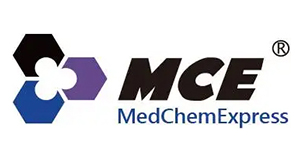Trimebutine (maleate) (Standard), CAS 34140-59-5
Trimebutine (maleate) (Standard), CAS 34140-59-5
SKU
MEXHY-B0380AR-25
Packaging Unit
25 mg
Manufacturer
MedChemExpress
Availability:
loading...
Price is loading...
Product Description: Trimebutine maleate (Standard) is the analytical standard of Trimebutine maleate (HY-B0380A). This product is intended for research and analytical applications. Trimebutine maleate is a multi-target inhibitor and opioid receptor agonist with antimuscarinic activity. Trimebutine maleate inhibits L-type Ca2+ channels and large-conductance calcium-activated potassium channels (BKCa channels), thereby inhibiting extracellular calcium influx and potassium ion efflux. Trimebutine maleate also targets Toll-like receptors, inhibits Toll-like receptor 2/4/7/8/9 signals, and inhibits LPS-induced IRAK1 activation, as well as ERK1/2, JNK and NF-κB activation, thereby exerting anti-inflammatory effects. Trimebutine maleate also induces tumor cell apoptosis by inhibiting the AKT/ERK pathway. Trimebutine maleate also inhibits excessive contraction of smooth muscle and can be used in the study of gastrointestinal disorders such as irritable bowel syndrome (IBS)[1][2][3][4][5][6].
Formula: C26H33NO9
References: [1]Fan YP, et al. Trimebutine Promotes Glioma Cell Apoptosis as a Potential Anti-tumor Agent. Front Pharmacol. 2018 Jun 21;9:664./[2]Tan W, et al. Effects of trimebutine maleate on colonic motility through Ca²+-activated K+ channels and L-type Ca²+ channels. Arch Pharm Res. 2011 Jun;34(6):979-85./[3]Long Y, et al. Effectiveness of trimebutine maleate on modulating intestinal hypercontractility in a mouse model of postinfectious irritable bowel syndrome. Eur J Pharmacol. 2010 Jun 25;636(1-3):159-65./[4]Xu J, et al. Trimebutine, a small molecule mimetic agonist of adhesion molecule L1, contributes to functional recovery after spinal cord injury in mice. Dis Model Mech. 2017 Sep 1;10(9):1117-1128./[5]Ogawa N, et al. Trimebutine suppresses Toll-like receptor 2/4/7/8/9 signaling pathways in macrophages. Arch Biochem Biophys. 2021 Oct 30;711:109029./[6]Cenac N, et al. A novel orally administered trimebutine compound (GIC-1001) is anti-nociceptive and features peripheral opioid agonistic activity and Hydrogen Sulphide-releasing capacity in mice. Eur J Pain. 2016 May;20(5):723-30.
CAS Number: 34140-59-5
Molecular Weight: 503.54
Research Area: Cancer; Metabolic Disease; Inflammation/Immunology; Neurological Disease
Target: Akt;Apoptosis;Calcium Channel;ERK;IRAK;JNK;NF-κB;Opioid Receptor;Potassium Channel;Reference Standards;Toll-like Receptor (TLR)
Formula: C26H33NO9
References: [1]Fan YP, et al. Trimebutine Promotes Glioma Cell Apoptosis as a Potential Anti-tumor Agent. Front Pharmacol. 2018 Jun 21;9:664./[2]Tan W, et al. Effects of trimebutine maleate on colonic motility through Ca²+-activated K+ channels and L-type Ca²+ channels. Arch Pharm Res. 2011 Jun;34(6):979-85./[3]Long Y, et al. Effectiveness of trimebutine maleate on modulating intestinal hypercontractility in a mouse model of postinfectious irritable bowel syndrome. Eur J Pharmacol. 2010 Jun 25;636(1-3):159-65./[4]Xu J, et al. Trimebutine, a small molecule mimetic agonist of adhesion molecule L1, contributes to functional recovery after spinal cord injury in mice. Dis Model Mech. 2017 Sep 1;10(9):1117-1128./[5]Ogawa N, et al. Trimebutine suppresses Toll-like receptor 2/4/7/8/9 signaling pathways in macrophages. Arch Biochem Biophys. 2021 Oct 30;711:109029./[6]Cenac N, et al. A novel orally administered trimebutine compound (GIC-1001) is anti-nociceptive and features peripheral opioid agonistic activity and Hydrogen Sulphide-releasing capacity in mice. Eur J Pain. 2016 May;20(5):723-30.
CAS Number: 34140-59-5
Molecular Weight: 503.54
Research Area: Cancer; Metabolic Disease; Inflammation/Immunology; Neurological Disease
Target: Akt;Apoptosis;Calcium Channel;ERK;IRAK;JNK;NF-κB;Opioid Receptor;Potassium Channel;Reference Standards;Toll-like Receptor (TLR)
| SKU | MEXHY-B0380AR-25 |
|---|---|
| Manufacturer | MedChemExpress |
| Manufacturer SKU | HY-B0380AR-25 |
| Package Unit | 25 mg |
| Quantity Unit | STK |
| Product information (PDF) |
|
| MSDS (PDF) |
|

 Deutsch
Deutsch










